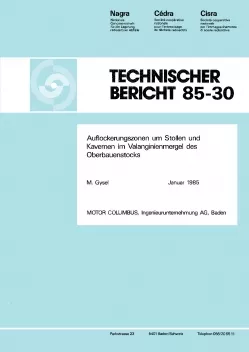
Technischer Bericht NTB 85-30
Auflockerungszonen um Stollen und Kavernen im Valanginienmergel des Oberbauenstocks
At the Oberbauenstock Type B repository model site for low and intermediate level radioactive waste, tunnels and caverns will be surrounded by decompressed zones which are induced through the stress redistributions caused by the tunnelling action. The following report treats the formation, the extent and the inherent properties of the decompressed – or loosened – zone. The loosening may be accompanied by an increase of the hydraulic permeability (k-value). For the Valanginian marl (host rock), the k-value is considered to change from 10-10 m/s to approx.10-7 m/s. The swelling potential of the marl induces the so-called joint swelling in the plastified rock zones; this can reduce the final k-value to 10-8 – 10-9 m/s. Over long periods of time, creep of the marl under the given overburden stress might, following backfilling of the tunnels and caverns, additionally reduce the permeability. However, present indications are that the viscosity of the Valanginian marl is too high to allow a significant recompression of the decompressed zones. The permeability, however, may possibly be reduced by grouting techniques. It is proposed to study the mechanisms of rock loosening, joint swelling and creeping in more detail by means of in situ and laboratory investigations.
The report includes the large-scale determination of the permeability of naturally jointed rock, making use of seepage measurements on power tunnels in the Swiss Alps. Comparisons may then be carried out between the naturally jointed rock and the "artificially" jointed decompressed rock zone with regard to their permeability.
